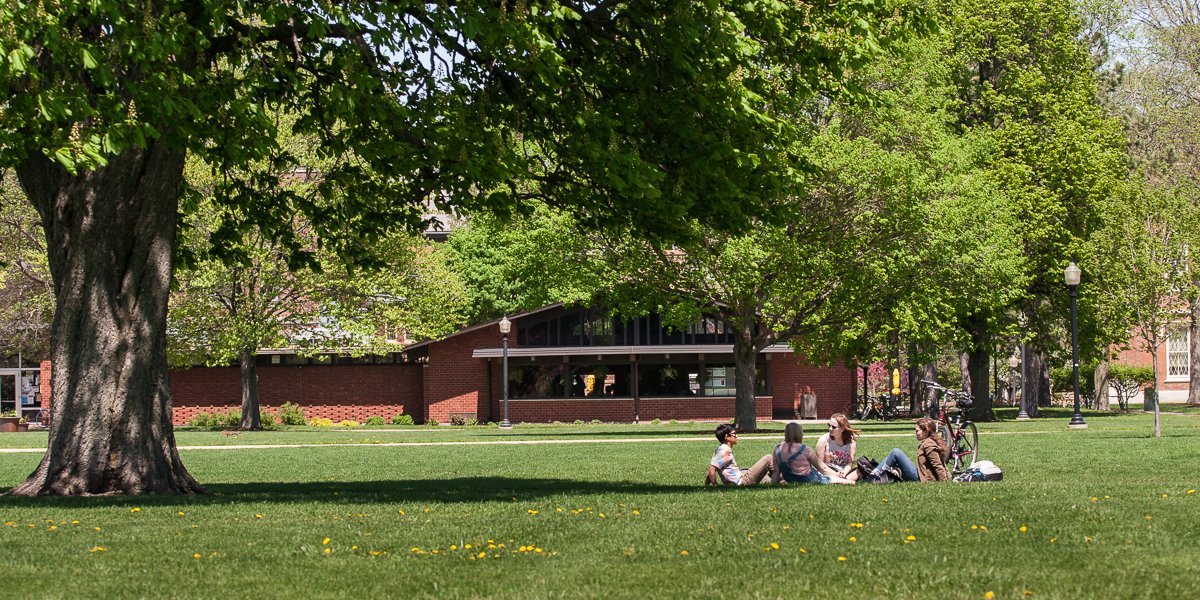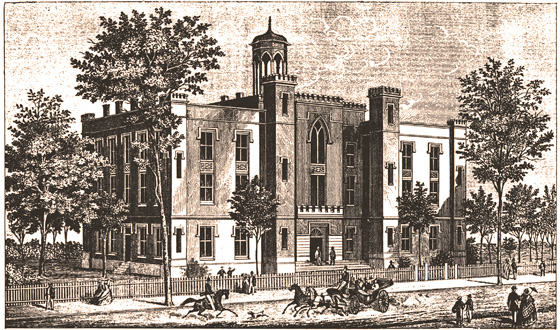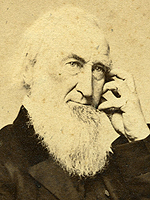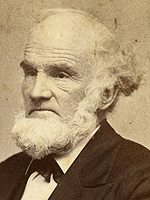

Venture Boldly



Pictured: Lithograph of Knox's Old Main. |
During the decades of the 1840s and 1850s, the Congregationalists and Presbyterians affiliated with Knox College frequently debated diminutive religious differences between their two sects. This ongoing dispute culminated in a personal feud between the College's second president, the Congregationalist Jonathan Blanchard, and its founder, Presbyterian George Washington Gale, for denominational control of the College's administration.
In early 1845, Knox College founder and trustee George Washington Gale led the College's Board of Trustees in asking for the resignation of Reverend Hiram Huntington Kellogg from the office of President of the College. Kellogg had been one of the principal proponents of Gale's plans to establish a religious college in the West, serving on the exploratory committee responsible for the logistics of Galesburg's settlement and as a member of the College's board of trustees before his selection as its first president. Ostensibly, Kellogg's dismissal was prompted by several years of financial duress for the College under his stewardship; in fact, Kellogg's resignation was affected by political and religious considerations beyond his efficacy as a fundraiser. Personally, Gale had grown aggravated with Kellogg's progressively vocal congregationalism, which he viewed as an encroachment to the traditionally Presbyterian administration of the College.

Kellogg |
Kellogg's resignation signaled the formal inauguration of a sectarian schism between the Congregationalists and the Presbyterians affiliated with Knox College. The Congregationalists believed that the Presbyterians, represented within the community by Gale, were morally obligated to cease affiliation with their national governing body -- the national Assembly -- on the basis that it was composed, in part, of southern churches that endorsed slavery. The controversy came to a head during the presidency of Kellogg's successor, Jonathan Blanchard, who personally agitated against Presbyterianism and its stalwart, George Washington Gale.
Galesburg's settlers were a combination of Congregationalists and Presbyterians. In the settlers' home of Whitesboro County, New York, the two denominations functioned as one due to the "Plan of the Union," an arrangement which organized the two congregations under a single minister. Gale opted not to follow this arrangement in regards to his venture in Galesburg. He felt the hierarchy of the Presbyterian Church would prove more beneficial to the College, and thus they should assume the predominant role in the College's affairs. Trustees Silvanus Ferris and Nehemiah Losey supported Gale's decision, stating that the College should be "under the influence and direction chiefly -- but not exclusively -- of that denomination [Presbyterianism]." Shortly after Galesburg's foundation, however, the national Presbyterian Assembly was shook by internal dissension, presenting a significant challenge to the church's stability.
A contingent of Northern churches boycotted the 1838 Presbyterian National Assembly, affecting a philosophically-rooted rift within the national church. The underlying cause of this split was the organization of the national church itself; Presbyterian churches were subordinate to a regional synod, which deferred to a national assembly including both southern and northern churches. The national assembly, in an effort to appease its southern membership, abstained from condemning the practice of slavery despite vehement and principled objections from a significant number of the Northern congregations. For these Presbyterians -- George Washington Gale and the Galesburg settlers included -- the national assembly's policy on slavery was not defensible as a moral doctrine. They left with the Assembly, but stopped shy of disassociating with Presbyterianism, instead forming a separate faction referred to as the "New-School" Presbyterians. The New-School Presbyterians' continued communion with the Presbyterian Church bothered some of the more idealist congregants -- such as Jonathan Blanchard and Hiram Kellogg -- who converted to Congregationalism, which provided more local autonomy.

Blanchard |
Like Kellogg, Jonathan Blanchard was ordained a Presbyterian minister, but his strong moral objection to slavery led him to identify as a Congregationalist after the split in the Presbyterian Assembly. Educated at Middlebury College, where he received a Bachelor's degree in 1832, Blanchard pursued postgraduate studies at Andover in 1834 and Cincinnati's Lane Theological Seminary in 1837. While at Lane, Blanchard was active in the college's abolitionist culture, preaching in black churches and lecturing in front of the city's Ladies' Anti-Slavery Society. Following his studies there, Blanchard began a pastorate at Cincinnati's Sixth Presbyterian Church, gaining an audience from which he would subsequently establish himself as a nationally renowned abolitionist in the following years. Blanchard believed slavery "was defying God," and advocated its immediate abolition. Strong convictions about the inherent evil of slavery characterized him throughout life; Blanchard did not censor his opinions, radical at the time, despite the considerable criticism he received for them. Abolitionism was widely detested in Antebellum America, derided by opponents and advocates of slavery alike. It was a reality Blanchard was all too cognizant of, as during his time in Cincinnati Blanchard witnessed "three days and nights in the power of a mob" that targeted abolitionist printing presses for destruction.
Blanchard's stature appealed to Gale in his search for a candidate to fill Kellogg's vacancy. With Kellogg's parting endorsement, Gale and the board of trustees extended an invitation to Blanchard to become the College's second president, and he accepted. As Earnest Calkins describes the hiring, "It was [Blachard's Presbyterianism] as much as his eminence and influence that made Gale so eager to have him as President of the College." But if Gale had anticipated a Presbyterian president, Blanchard did not fulfill his expectations. Blanchard's piety pivoted on the slavery issue, which extended to encompass his disapproval of not only it's practice, but tacit approval of it; which is how he came to interpret the reluctance of the New-School Presbyterians to dissociate with the Presbyterian Church.
Blanchard's utter lack of tolerance for slavery and all association with it predisposed him towards the College's Congregationalists. Unlike Presbyterianism, Congregationalist churches were autonomously governed; this meant individual churches could dictate their own responses to the issue of slavery. Blanchard's support of the Congregationalists exacerbated tensions with the Presbyterians and caused Blanchard to run personally afoul of George Washington Gale, who had come to resent the Congregationalists and Blanchard individually. The temperament of the two men accentuated their religious differences. Blanchard was fiery and uncompromising, willing to agitate for his moral beliefs; Gale was more than willing to meet his challenge. Gale construed the criticism of Presbyterians on the slavery issue as a threat to their influence within the College, and used his influence to check Congregationalism within the College.
The first open sign of struggle between the two sects came three years after Blanchard's appointment in 1849. In an effort to secure Presbyterian control of the College's board of trustees, Gale nominated his son, Washington Selden Gale, and a sympathetic attorney, Orville H. Browning, for election to the board. There had previously been a numerical balance between Presbyterians and Congregationalists on the board, but the election of Orville Gale and Brown compromised this equilibrium. Blanchard, understanding the implications of the elections, resigned to protest the explicit power grab by the Presbyterians, only to withdraw his resignation when the elections were successfully challenged. In a counter-protest, the Presbyterians walked out on the proceedings to protest the annulment of their candidates' elections, only to then have the Congregationalists, with a minimal quorum, elect six new members in their absence. Unable to come to an understanding, the two parties had to resort to legal channels to resolve the disputed elections, at which point the second round of elections were also declared null by a circuit court judge.
As the situation on the Board of Trustees and within the College became more polarized, Galesburg as a community felt the effects of the religious contest. In 1851, Gale and the Presbyterians withdrew from the Old First Church, which had housed both the Congregationalists and the Presbyterians, and formed the First Presbyterian Church exclusively for Galesburg's Presbyterians. Galesburg's first newspapers served as another outlet for the sectarian struggle. The Knox Intelligencer supported Gale, while the Northwestern Gazetteer backed Blanchard; both papers, however, expressed concern about the College's future viability in light of the growing religious tensions, and were pleased when a "compromise" was reached between the board members in the wake of the illegal elections in 1849. The compromise, which took the form of an informal gentleman's agreement, was designed to maintain a permanent equilibrium on the board, a balance of power between both sects to minimize partisan politics.
In 1853, trustee Flavel Bascom, a Congregationalist, moved to officially adopt the principle of the compromise within the language of a resolution, but the motion was tabled. The following year in 1854, Orville Browning, a Presbyterian, successfully passed a similar resolution. In Galesburg, evidence that the sectarian divide was growing larger came with the formation of a yet another new church, when forty-seven parishioners, expelled from the Old First Church in 1855, formed a new Congregational Church, later known as the "Brick Church." The parishioners of Brick Church, in rebuttal, enlisted the services of outspoken Congregationalist Edward Beecher, the brother of Harriet Beecher Stowe, to serve as minister and representative.
In June 1856, the election of a new Presbyterian member to the board gave Gale's Presbyterians a majority, and in June 1857, with tensions rising in the town, all civility collapsed. Compromise endured only so long as the Board was equally composed of Congregationalists and Presbyterians, but the underlying philosophical differences between board members of the two denominations had remained, festering. With the upper hand, a committee chaired by Presbyterian Orville Browning was appointed to take decisive action on the "differences" between Blanchard and Gale, and on June 24, the committee requested the resignation of both Jonathan Blanchard as President and George Washington Gale as Professor of Belles-Lettres, a secondary capacity he held in addition to his position as a board member. A narrow 11-10 vote sponsored the board's request, and in response both men resigned.
The Board's request feigned equal treatment by asking for the mutual resignations of both men, but allowed Gale to retain his position as a trustee of the College while severing Blanchard's ties with the school completely. This fact, not lost on many, prompted a public outcry from students and townspeople alike. Several students transferred away from Knox following Blanchard's dismissal, and all but one of the members of the graduating class refused to deliver their speeches at the 1857 commencement exercises in an act of poignant protest. Knox students were so critical of Blanchard's dismissal that the board was compelled to retain Blanchard as president for another year so as to pacify them.
Blanchard stayed on for one more year and then resigned; he then moved to Wheaton, Illinois, and founded Wheaton College. This did not, however, immediately quell the sectarian struggle. Even with the Congregationalists' spokesman gone, the controversy surrounding his dismissal and the search for his replacement extended the religious discourse. The trustees eventually replaced Blanchard with Presbyterian Harvey Curtis, but his appointment was the last that was religiously decided. Recognizing the damage that sectarianism had done to the College, the trustees decided in 1862 that the "election of teachers, professors, and trustees should be controlled by a reference to the good of this institution rather than the denominational bearing such election may be supposed to have."
Sectarianism exacted a heavy toll on the College and had a significant influence on its future. Blanchard's term in office was very successful, and his dismissal left the school without a talented executive. President Harvey Curtis's administration did not take the activist role in social affairs that Kellogg and Blanchard's had, and the College and town's reputation as an abolitionist haven diminished in the coming years. The longest-reaching consequence of the College's sectarianism during the 1840s and 1850s, however, was a gradual shift towards secularism. The Board of Trustees' 1862 decision to "avoid all denominational contests and rivalry" changed the way religion was viewed within the College; in 1868, the Board of Trustees unanimously elected the Reverend Gulliver, a Congregationalist, as president. Although it wouldn't be until after the Second World War that Knox officially dropped its religious affiliation, the sectarian schism curtailed the future role of religion at the College. The absence of religious conflict ensured that the college could move forward rather than risk fragmentation.
Grant Forssberg '09
BibliographyArchival Sources:
|